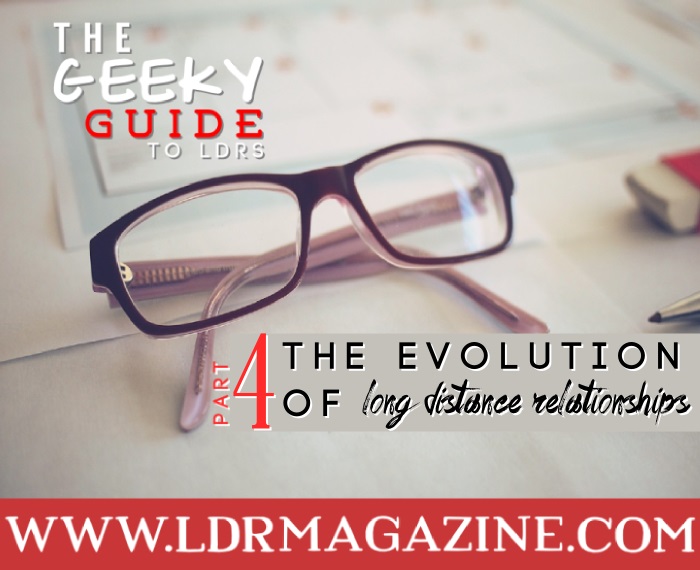Welcome to the third part in our Geeky Guide to LDRs series. If you missed our first two parts on what attracts us to others, how attraction develops into love and how LDRs are able to work you can read part one here, part 2 here and part 3 here.
Laptops, smartphones and a constantly connected society are just a few of the key drivers of long distance relationships today. We can chat with our partner at any time, in any place. We can send anything from photos and videos to audio clips. It is easier than ever before to communicate across long distances. And yet, we still find long distance difficult. There are time differences, a lack of physicality, and sometimes what we mean can get lost in translation. Long distance relationships are difficult, it is true.

Even in today’s connected society, LDRs are challenging.
But, despite all of this, we are fortunate that we live in such a connected day and age. These problems pale in comparison to those experienced by our predecessors.
There was even a day when the only way to communicate in a long distance relationship was to undertake an epic journey. And even then, there would have been no guarantee that your partner would even still be there when you arrived!
We have always known that there were early long distance relationships. But a new study from the University of Utah might have found evidence that they predate even our own expectations.
The study in question looked at two African tribes and focused on their spatial awareness and navigational skills. It found direct correlations between performance and number of lovers.
While this might seem like an odd connection to make, and even stranger in terms of long distance relationships, it could suggest that our spatial abilities were formed as a result of early humans traveling to maintain romantic interests.
One example of where this form of travel would have been required would have been within pre-civilisation, hunter-gatherer societies. In these times, men would often leave for unknown periods of time. Of course, in these days the average life span of a person was particularly low, with most only just living into their 30’s.
Because of this, precious moments of life that could have been shared together were cut short. However, hunter-gatherers often had no choice but to leave their partners in order to help the whole community survive, so being able to quickly and efficiently find their way home would have been of utmost importance.

Roman soldiers are a prime example of those that would have to leave home for months at a time.
As well as the hunter-gatherer couple, we also cannot fail to acknowledge the war-torn couple. Since the dawn of human civilisation, war has ravaged numerous generations.
Some of the earliest examples date back to gristly skirmishes waged over control of the river Nile during the Mesolithic era (nearly 13,000 years ago). With no methods of communicating, war-torn couples would have been forced to wait out their partners’ return, with no guarantee that they would ever come back.
Since then, long distance relationships have become progressively easier. There have been a huge number of milestones in their long and convoluted history, but these are some of the most important, each of which marked a new era of possibilities for long distance couples.
The first is from China circa 900 BC, where first postal service was used. This meant that couples were able to directly send letters to each other, although response times could be considerable. Next, in Greece, circa 770 BC, homing pigeons gained popularity for being able to deliver messages to long distance lovers much quicker, becoming the first method of airborne communication.
Over the following centuries, small incremental improvements in communication benefited long distance couples. But it was not until considerably later, around 1814 that our next significant milestone, photography was first introduced. Long distance couples gravitated towards the opportunity of being able to share images of their loved ones.

Telephones changed the way long distance couples communicated forever.
Only a few short years later in 1843, long distance couples were able to use telegraphs to transmit messages to each other in significantly quicker times than the traditional postal service.
However, it was not long before telegraphs were outdated by the telephone, which revolutionised long distance relationships. It was our first way of hearing our partners voices, and gave us the ability to communicate with them as though they were there standing beside us. It was in 1914 that the very first phone call was ever made, bridging overseas lovers together in a completely new way.
In the most recent decades, since the advent of the telephone, we have seen Moore’s Law in action. This is the principle that technology doubles its capabilities every 24 months.
As a result, we have now access to a huge and vast array of tools that allow us to connect with our partner in ways those before us could only dream of. Some examples include: cell phones, text messaging, social networking, web chat and instant messaging.
With all of this technology at our fingertips now, who knows what the future will hold for long distance couples? We don’t know, but we cannot wait to find out!




March 16, 2015 at 9:21 amWow ! I never thought LDR can be dated way back. Nice to know the history of LDR. It is just as good as it is now.